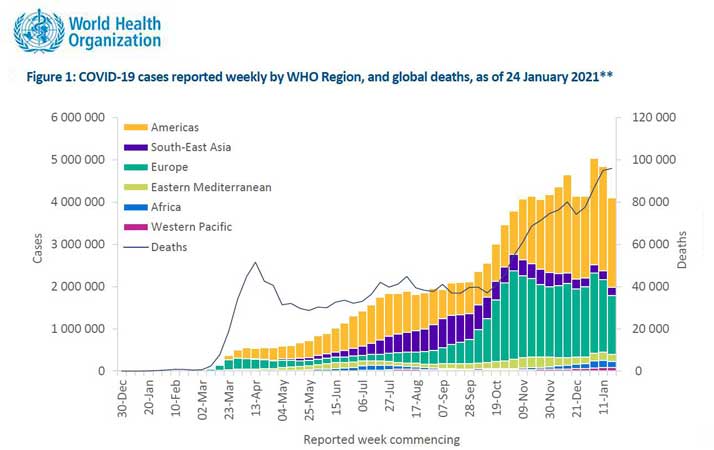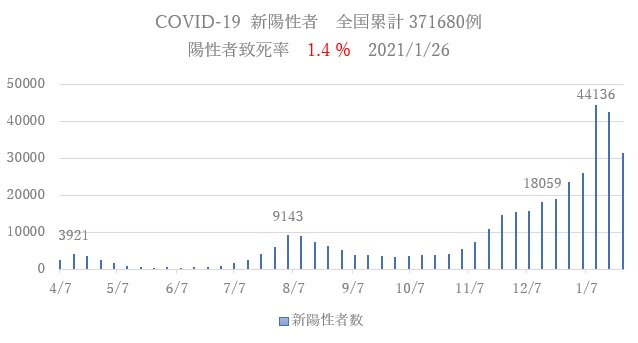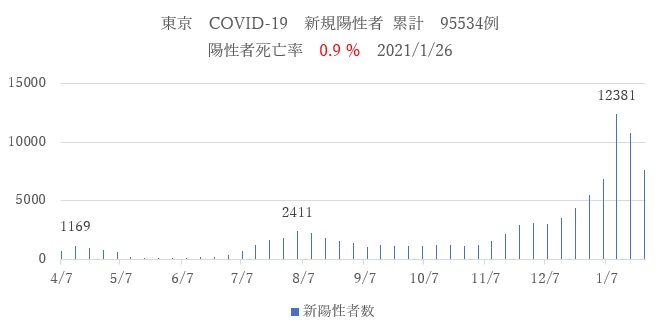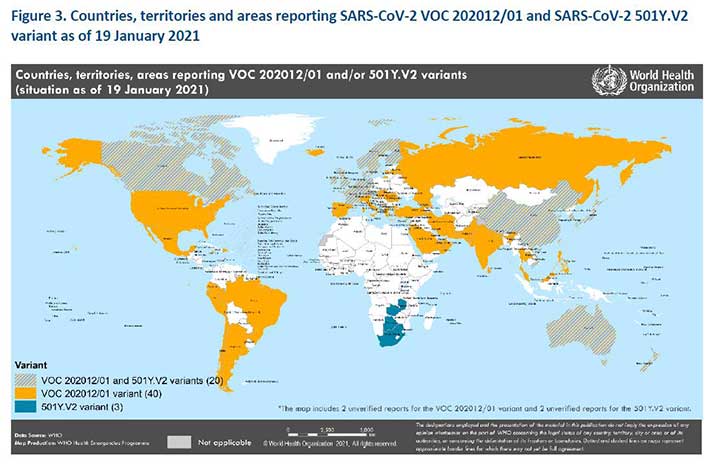SHARE
Services for the Health in Asian & African Regions (SHARE) = SHARE is a citizen sector organization (NGO) that engages in international cooperation mainly through providing health service.
HOME > News > Information of COVID-19(15)
- 【※updated】COVID-19(multi-language)
- Information of COVID-19(15)
- Information of COVID-19(vaccines)
- 《Request to the Government of Japan》Ease the protection of intellectual property rights and promote sharing and cooperating on pharmaceuticals and medical technologies, in order to accelerate efforts to overcome COVID-19 all over the world.
- Information of COVID-19(14)
- Information of COVID-19(13)
- Information of COVID-19(12)
- Information of COVID-19(11)
- SHARE Medical Information Line for Migrants is resumed in Oct.
- Information of COVID-19(10)
Information of COVID-19(15)

Information of COVID-19 (15)by SHARE 2021.2.1
1. Global and Japanese Situation regarding COVID-19
■Confirmed cases and new deaths due to COVID-19 worldwide(source: WHO, updated 2021/1/24)Case fatality rate: 2.2%

To cite fromWHO(World Health Orgbanization) :weekly-epidemiological-update---27-january-2021
With approximately 4-5 million new positive cases and over 85,000 new deaths per week worldwide, the COVID-19 epidemic seems to have reached the upper limit of the rate of case increase. The case fatality rate is 2.2%. The total number of positive cases has reached almost 100 million, and the number of deaths has exceeded 2.1 million. (WHO, updated 2021/1/24)
The status of the case increase in the third week of January:
- The five countries with the highest number of reported cases worldwide are the United States, Brazil, the United Kingdom, Russia, and France. The U.S. continuing to experience the highest rate of increase, with more than 200,000 new cases being confirmed every day.
- The number of new positive cases in the Americas region is high, especially in the U.S., Brazil, and Colombia.
- In the third week of January, the Africa region saw the notable increases in South Africa, Nigeria, and Zambia.
- In the Asian region, increases are seen in Japan, Malaysia, the Philippines, and Indonesia. In India, although the absolute number is large, there is a downward trend.
■Weekly confirmed cases and deaths due to COVID-19 in Japan
Case fatality rate 1.4% (updated 2021/1/26)

■ Weekly confirmed cases of COVID-19 in Tokyo
Case fatality rate 0.9% (updated 2021/1/26)

- The number of new positive cases in Japan and Tokyo is thought to have increased sharply in the first and second weeks of January due to people's movement and outings during the Christmas and New Year holidays. A state of emergency has been declared in the Greater Tokyo area from January 8 (Tokyo, Chiba, Saitama, and Kanagawa), and in other seven prefectures from January 14 (Tochigi, Gifu, Aichi, Kyoto, Osaka, Hyogo, and Fukuoka). Since the third week of January, the number of new positive cases has been on a downward trend both in Tokyo and nationwide.
2. SARS-CoV-2 Mutant Strains

To cite fromWHO(World Health Orgbanization):weekly-epidemiological-update---19-january-2021
- Currently, several COVID-19 mutant strains are prevalent around the world.
- The new variant, called B.1.1.7 (VOC 202012/01), which emerged in the United Kingdom (UK) and has been reported in 60 countries as of January 19. The variant is observed to spread more easily and rapidly than other variants, but there is no evidence that it causes more serious illness or increased risk of death.
- In South Africa, a variant strain called 1.351 (501Y.V2) has emerged. It was originally detected in early October and has been reported in 23 countries as of January 19.
- A variant called P.1 appeared in Brazil and was detected in four travelers to Japan.
・https://www.who.int/publications/m/item/weekly-epidemiological-update---19-january-2021
・https://www.cdc.gov/coronavirus/2019-ncov/transmission/variant.html
3.Household Transmission
- The results of 54 related studies showed that the household infection rate of COVID-19 in 77,758 people was 16.6%, which was higher than those of SARS (7.5%) and MERS (4.7%). The household infection rate among symptomatic patients was 18.8%, which was higher than that of asymptomatic patients (0.7%). In total, 28.3% of the transmissions were through contact with adults, while 16.8% were through contact with children. The infection rate from spouses (37.8%) was higher than that from other family members (17.8%). The household infection rate tended to be higher when the number of people living together was small: 41.5% for those living with one other person and 22.8% for those living together with three or more people. Household Transmission of SARS-CoV-2 A Systematic Review and Meta-analysis
https://jamanetwork.com/journals/jamanetworkopen/fullarticle/2774102
4. Ten Facts about the "Now" of COVID-19
(Ministry of Health, Labour and Welfare: MOHLW; January 2020)- In Japan, about 209,980 people have been diagnosed with COVID-19, which is equivalent to about 0.3% of the total population.(2021/1/29)
- 2. The proportion of people diagnosed with novel coronavirus infections who become severely ill or die depends on their age, and tends to be higher among the elderly and lower among the young.
・1.6% of patients become seriously ill (0.3% in under 50 and 8.5% in 60 and above).
・1.0% of patients die (0.06% for those under 50 and 5.7% for 60 and above). - The elderly and those with underlying diseases (chronic obstructive pulmonary disease (COPD), chronic kidney disease, diabetes, hypertension, cardiovascular disease, and obesity) are more likely to develop serious symptoms. Pregnant women and those with a history of smoking are also considered to be more susceptible to infection.
- The number of infections and deaths per population in Japan has remained low compared to the global average and major countries.
- The period in which a person infected with the new coronavirus may infect others is considered to be from two days before symptom onset to seven to ten days after onset. It is also reported that within this period, viral shedding is particularly high immediately before and after the onset of illness.
- The risk of infection increases in three-C environments (Closed spaces, Crowded places and Close-contact settings), because SARS-CoV-2 is mainly transmitted through droplet and contact infections. It is also important to note that infection can easily occur in situations such as social gatherings with drinking, eating and drinking in large groups or for long periods of time, conversations without masks, living together in a small space, and switching places to stay.
- It has been observed that less than 20% of people diagnosed with new coronavirus infections also infected others, and over 80% have not infected others. Therefore, if an infected person takes infection prevention measures in three-C environments which will limit contacts and thus viral spread, the COVID-19 pandemic can be controlled.
- Tests for diagnosing novel coronavirus infection include PCR tests, antigen quantitative tests and qualitative tests, all of which are used to detect the presence of the virus in a person's body. With the development of new testing methods, it is now possible to use saliva or nasal swabs in addition to nasopharyngeal swabs, depending on the patient's condition and testing environment. The antibody test is designed to determine whether a person has had COVID-19 in the past, so it cannot be used to diagnose an infection at the time of the test.
- Mild cases often resolve spontaneously and symptomatic treatment such as antipyretics are given when necessary. In cases of respiratory failure, oxygen administration, steroids (anti-inflammatory drugs), and antiviral drugs may be administered, and if there is no improvement, intensive care with a ventilator or other equipment may be used. However, the elderly and those with underlying medical conditions should be aware that their condition may suddenly worsen.
- COVID-19 vaccines are being vigorously researched and developed overseas and in Japan. In some countries, emergency use of vaccines has been approved and vaccination has started. An application for approval of the vaccine has been filed in Japan, and the approval review is underway based on the results of clinical trials in Japan and overseas. Preparations are being made to ensure that those who wish to receive the vaccine will be able to do so as soon as the review is completed and approved. In general, vaccines are effective in preventing the onset and aggravation of infectious diseases. Researchers collaborating with Pfizer, Moderna, and AstraZeneca have published the interim results from a Phase III trial showed that fewer people who received the vaccine developed COVID-19 than those who did not. In general, while extremely rare, adverse reactions to vaccinations are possible. Adverse reactions to COVID-19 vaccines have been confirmed in clinical trials and ongoing other studies. ▶MOHLW
Written by Nakasa T, MD, Co-President of SHARE
■【Release】Information of COVID-19(ENGLISH)
■Useful URLs by multi-languages



